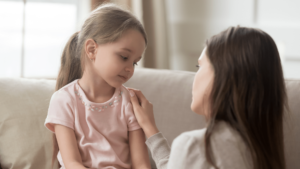Anxiety Disorders in Children
Growing up means facing new challenges and this can lead to uncertain and nerve-wracking situations that bring about anxiety in children.
What is Anxiety?
An article published in the Cambridge University Press defined anxiety as an uncomfortable experience characterized by emotional (unease, distress), cognitive (fears, worries, helplessness), physiological (muscle tension), and behavioral (avoidance) changes.
Anxiety is a normal emotion that everyone experiences at some point in their lives. It manifests with a variety of behavioral, affective, and cognitive responses. Just like adults, even children experience anxiety and it is regarded as a normal part of childhood.

Prevalence of Anxiety Disorders in Children
Anxiety disorders in children are the most common type of psychiatric problem in children. According to Lewis’s Child and Adolescent Psychiatry, the prevalence of anxiety disorders in children ranges from 4 to 20%. In several studies worldwide, the prevalence of anxiety disorders in children is greater than 10%.
Anxiety disorders in children is an umbrella term encompassing conditions such as phobias, separation anxiety, panic disorder, obsessive-compulsive disorders, and generalized anxiety disorders.
Children may experience nervousness, shyness, fear, and avoidance of certain situations. Previously thought to be benign, anxiety disorders in children can interfere with several daily life activities. These conditions can cause distress to children and impairment with emotional, behavioral, and social functions. They are often associated with an increased risk of school problems, low-paying jobs, and a poor outcome in life.
General Signs of Anxiety
Anxiety disorders in children are often underdiagnosed and less paid attention to, compared to other childhood psychiatric problems. When children feel anxious, they are not often as vocal as adolescents or adults. Here are some general signs that your child may be having an anxiety disorder:
In young children, you may notice:
- Irritable and easily annoyed
- Difficulty with onset sleeping or maintaining sleep
- Restlessness and wakefulness at night
- Bedwetting
For older children, these may be observed:
- Lack of confidence in daily activities
- Hesitancy in trying out new things
- Demonstrate eating and sleeping problems
- Difficulty concentrating in school work
- Shy away from social situations
- Avoiding school
- Constantly thinking of negative thoughts
When is Anxiety a Problem for Children?
Anxiety disorders in children can potentially become a problem when it starts to get in the way of and interfere with their everyday life. When a child does not outgrow the worries experienced when the child was younger, it can potentially progress to an anxiety disorder.
Severe anxiety disorders can harm a child’s mental and emotional health, as well as reduce their self-esteem and self-confidence.

Seeking Help for Anxiety Disorders in Children
Drug therapy exists for these disorders, but only a few parents actually seek help for their clinically anxious children. If your child’s anxiety disorder persists or worsens, or affects their well-being, it may be a good idea to seek some professional help.
The first step is to talk with a mental health specialist and get an evaluation and suggestions regarding treatment. It is important to get a careful evaluation to get the best diagnosis and treatment. MindShift Psychological Services has several accredited healthcare providers to help you with that. Be it behavioral therapy, family counseling, one-on-one sessions, Mindshift Psychological Services will provide you what you need. Visit any of the branches near me in California near me in Los Angeles, Newport Beach, and Corona.



